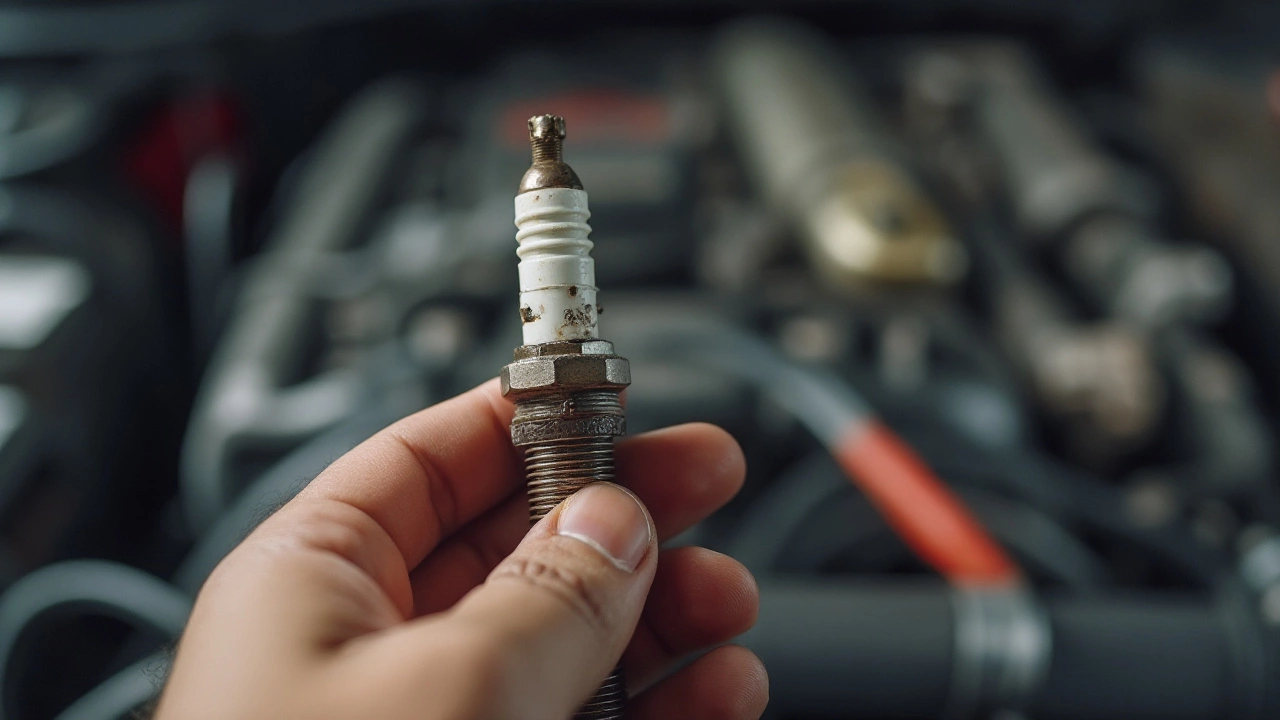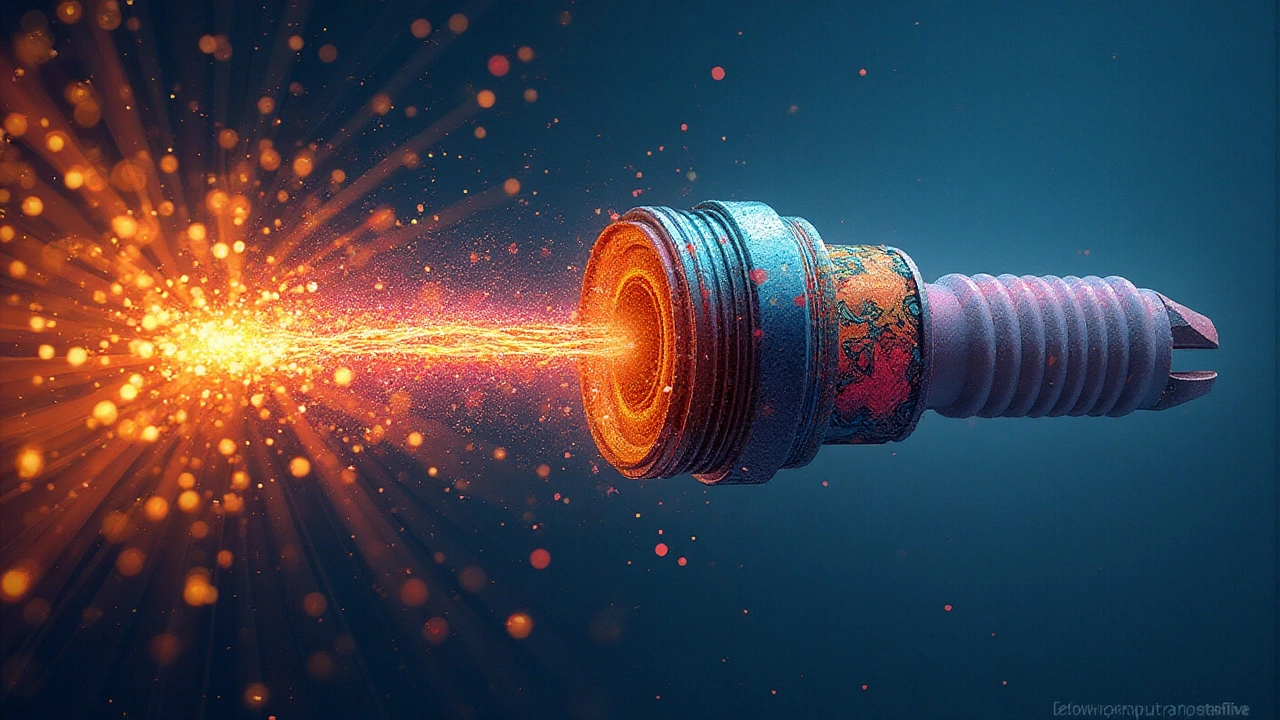 Jan, 30 2025
Jan, 30 2025
Spark plugs might not capture the spotlight when discussing your vehicle, but these small powerhouses quietly hold a significant role in engine performance. They ignite the mixture of air and fuel, setting off the combustion necessary to power your car. But how long do these unnoticed heroes last before they face retirement?
Spark plug lifespan isn't a one-size-fits-all. It hinges on the type, the engine they nestle within, and the driving conditions they brave. Longevity might vary from as little as 20,000 miles to a substantial 100,000 miles. Whether you're a weekend driver or someone often stuck in traffic, understanding the lifespan of spark plugs can save a lot of trouble down the road. This article aims to shed light on the topic, offering insight and tips to maximize their efficiency.
- Understanding Spark Plug Lifespan
- Factors Affecting Longevity
- Recognizing Signs of Wear
- Extending Spark Plug Life
- Proper Maintenance Practices
Understanding Spark Plug Lifespan
Spark plugs play a crucial role in an engine's operation, acting as the bridge for electrical energy to pass through the combustion chamber and ignite the air-fuel mixture. When discussing their lifespan, it's essential to understand the different types of spark plugs available. The three main categories are copper, platinum, and iridium. Each type bears unique characteristics impacting how long they can efficiently operate before reaching the end of their service life.
Copper spark plugs, while cost-effective and known for excellent conductivity, are often the shortest-lived, generally lasting between 20,000 to 40,000 miles. On the other hand, platinum spark plugs provide a longer lifespan, typically extending from 60,000 to 80,000 miles, thanks to their durability and higher melting point. Iridium spark plugs are considered the high-end option. Their longevity can often exceed 100,000 miles due to their heat-resistant and wear-resistant nature.
The environment in which these plugs operate also significantly influences their lifespan. For instance, a car frequently driven in stop-and-go city traffic may need spark plug changes sooner than one cruising on highways. Each time you crank the engine, the spark plug initiates the combustion cycle, accumulating minor wear and tear. This wear progressively affects the spark plug's efficiency, necessitating eventual replacement.
In some vehicles, manufacturers specify broader maintenance intervals, reflecting the advancements in spark plug technology and engine systems. Always refer to your car's manual for manufacturer-recommended spark plug intervals. These recommendations ensure that the vehicle maintains optimal engine performance and fuel efficiency, preventing more severe problems that might arise due to faulty spark plugs.
The Lifespan of a spark plug is not just a question of miles but of observing the signs of wear as well. From engine misfires to increased fuel consumption, these symptoms can hint that the spark plugs need attention. It’s interesting to note that about 23% of all “check engine” warnings stem from faulty spark plugs. Addressing them promptly can prevent significant engine damage and extend the life of your vehicle's engine.
"In the intricate world of automobiles, spark plugs are the understated champions. Their diligence allows engines to heroically respond to our desires." — Auto Expert Journal
Factors Affecting Longevity
When we talk about the lifespan of spark plugs, it's like discussing a dance influenced by multiple partners—each having its own impact. The materials used in spark plugs are a critical determinant. Types like copper, platinum, and iridium plugs each bring distinct durability levels. Copper plugs, while excellent conductors, often have a shorter life span compared to iridium plugs, which are built to brave the conditions up to 100,000 miles. The choice of material directly impacts not only their durability but also performance, especially as it pertains to your vehicle's unique engine needs.
Diving deeper, driving conditions play a pivotal role as well. For someone frequently driving in the city with lots of stop-and-go traffic, spark plugs might wear out faster than for those cruising consistently on highways. City driving subjects the engine components to repeated heating and cooling cycles, accelerating wear and tear. Elevations, humidity levels, and even road quality further intertwine with engine demands to impact the longevity of spark plugs. It's akin to the difference between a calm hike and a rugged mountain climb.
The health of your vehicle's engine is another influential factor. Engines that aren't properly tuned or have an imbalance in fuel and air mixture often stress spark plugs. Such conditions lead to premature deterioration. Ensuring your engine breathes clean air and receives the right dose of fuel not only improves efficiency but also extends the lifespan of components like spark plugs. Regular check-ups act like health check-ups for your car; they often surprise you by catching issues that might otherwise be missed.
The type of fuel your engine consumes is worthy of mention too. With variations in octane and ethanol levels, some fuels may facilitate a cleaner burn than others, translating to less residue on the spark plugs. Advanced fuels, with additives designed to burn cleaner and leave fewer residues, give spark plugs an easier task, thus extending their life. This factor often appeals to drivers mindful of not only performance but also environmental impacts, nudging them towards fuels that enhance engine performance across its components.
Now, let's touch upon the overall vehicle maintenance regimen. Inconsistent or neglected maintenance routines jeopardize spark plug lifespan. Changing oil, cleaning air filters, and attending to other seemingly minor tasks collectively support a healthy engine. Such practices ensure that spark plugs experience less strain and fouling from engine deposits.
"Routine maintenance is like an insurance plan for your engine," notes the Car Care Council, emphasizing how a well-maintained car coaxes the best out of its spark plugs and other components.
Finally, keeping an eye on the check engine light can prove immensely preventative. This light serves as an early warning system for things to come, including spark plug issues. Ignoring it can mean running your vehicle under unhealthy conditions, silently wearing down spark plugs before their expected time. Addressing issues signaled by the light promptly often busts the bubble of problems before they fully inflate, preserving your spark plugs in a state of longevity.

Recognizing Signs of Wear
Keeping an eye out for the signs that a spark plug might be reaching the end of its life can prevent unexpected engine trouble down the road. One of the most noticeable indicators of a worn spark plug is a noticeable change in engine performance, often manifesting as misfires or a rough idle. You might find yourself pressing the accelerator more than usual, only to feel a lethargic response from your engine, which can signal that something isn't sparking quite right. Another tell-tale symptom is decreased fuel efficiency. As spark plugs deteriorate, they can sometimes fail to efficiently ignite the air-fuel mixture, leading to excess fuel consumption. This uptick in fuel use shouldn't be ignored, as over time, it can cause a dent in your wallet as well as contribute to environmental pollution.
A quick check of the spark plugs themselves can reveal even more clues. Pulling them out for a visual inspection, you might notice a build-up of deposits. These can appear in a variety of forms: oil residues, carbon deposits, or even a slight melting of the plug tips. Each of these points to different potential issues with the engine system, from oil leakage to incorrect fuel mixtures. It's often said, "A single visual can speak louder than words," a truth that rings particularly sound in the world of car maintenance. A black powdery deposit often means the fuel mixture is too rich, while white deposits might suggest an overheating engine. Meanwhile, a worn electrode gap can also be a clear sign of wear. The gap between the center and side electrodes of the spark plug affects the spark and plays a critical role in the ignition process. Over time, this gap can widen, diminishing the strength and efficiency of the spark.
Sounds may also provide a hint of spark plug wear. Subtle popping noises during acceleration or right under the hood can be indicative of an ignition system struggling to perform optimally. Likewise, starting problems on cold mornings might have more to do with failing spark plugs than just the outside chill. Recognizing these audio signs early can prevent larger engine issues that arise from neglected spark plug maintenance. And though it may appear less common, sometimes your vehicle might display dashboard lights signaling engine trouble. Modern vehicles have an array of sensors that keep track of engine efficiency, providing feedback if something doesn't seem right. These alerts shouldn't be taken lightly, even if the drive feels seemingly smooth. The awareness of potential spark plug failure isn't just about listening to the vehicle but also acknowledging its behaviors and the signs it offers.
"An ounce of prevention is worth a pound of cure," Benjamin Franklin famously stated, and maintaining your vehicle signs echoes this sentiment brilliantly.
Your vehicle, much like a living, breathing organism, often communicates through signals and performance changes. By recognizing these signs of wear on spark plugs early, costly repairs might be avoided and your car's longevity ensured. Understanding these concepts empowers drivers not only to respond to symptoms but to preemptively manage wear, contributing to a confident and reliable driving experience.
Extending Spark Plug Life
Extending the life of your spark plugs is crucial not just for the health of your engine but also for saving on unnecessary costs. Regular maintenance practices can significantly enhance their longevity, ensuring your vehicle performs at its best. One of the primary steps you can take is monitoring the quality of fuel you use. Low-quality fuels may contain impurities that could cause deposits to form on spark plugs, reducing their effectiveness and lifespan. It is wise to opt for reputable fuel brands that ensure optimal combustion. Also, think about a periodic use of fuel additives designed to clean the engine and its components, including spark plugs, from harmful deposits. This can be particularly beneficial if you often use your vehicle for short trips where the engine doesn't reach optimal operating temperature.
Maintaining the correct gap in your spark plugs is another vital aspect. Over time, the gap between the electrode and the plug can widen, leading to inefficient ignition. It is recommended to check this gap and adjust it if necessary, based on your vehicle's specifications. Investing in a simple tool, like a gap gauge, can help you regularly monitor and adjust this. Many vehicle owners overlook this simple task, but it can drastically improve engine performance and the longevity of plugs. Interestingly, technological advancements have produced iridium and platinum spark plugs known for their durability and ability to maintain the required gap longer than standard ones. While they come at a higher initial cost, they offer substantial long-term savings.
Avoiding aggressive driving can also play a role. If you consistently put your vehicle under excessive strain, this can cause the engine to operate at higher temperatures than necessary. Such conditions can accelerate the wear and tear of vital components, including spark plugs. Drive smoothly and stay within speed limits to relieve stress on your engine. If you're fond of the gas pedal, be mindful because this might force replacements sooner than anticipated. A respected mechanic once noted, "The driving habits you forge can either extend the life of your car's engine or slowly chip away at its prime years."
"Good maintenance breeds longevity, while neglect paves the road to premature failures," a seasoned car enthusiast often advises his peers.
In keeping the engine bay clean, ensure that moisture doesn't find its way into the spark plug compartments. Moisture can lead to misfires and corrosion, reducing efficiency. Using dielectric grease on the plug boots can create a moisture-resistant barrier, contributing to the health of the ignition system. In cases of vehicles frequently exposed to rainy or humid climates, the practice of periodically inspecting and cleaning the spark plug area is invaluable.
Scheduled tune-ups must not be ignored, as these are crucial for identifying issues before they escalate. During these sessions, mechanics often check the condition of spark plugs, cables, and other ignition system parts. Addressing concerns during these appointments helps in averting unexpected breakdowns and sustaining fuel efficiency. With modern diagnostics, even a seemingly minor fault gets flagged, providing vehicle owners with a chance to fix issues preemptively. In essence, treating your spark plugs with the same respect as any other vital car component is pivotal in extending their life, ultimately saving you on fuel costs and unexpected visits to the repair shop.

Proper Maintenance Practices
Ensuring your vehicle's spark plugs are consistently maintained is essential not only for longevity but also for keeping engine performance at its peak. When aiming for longevity, it's important to understand the art and science of maintenance. The approach isn’t just about replacing these parts when they appear worn-out but maintaining a proactive stance. Did you know that clogged spark plugs might reduce fuel efficiency by up to 30%? Regular check-ups can prevent such inefficiencies.
First and foremost, keeping a vigilant eye on your car's mileage is crucial. Traditional copper spark plugs generally last 20,000 to 30,000 miles, whereas iridium or platinum varieties can last upwards of 60,000 to 100,000 miles. An organized log of the miles traveled since the last replacement can help inform your maintenance schedule. Such an approach not only extends the life of the spark plugs but also ensures the engine runs smoothly and efficiently, easing your mind as you cruise the highways or chug through city traffic.
Cleaning the spark plugs plays a significant role in maintaining their health. A clean spark plug fires better, and it’s amazing how just a little attention in this area can save both time and energy later on. Using a wire brush or spark plug cleaner ensures that debris and carbon build-up are removed, which in turn helps maintain optimal engine performance. It's important to be gentle and methodical, as mishandling could cause damage and do more harm than good.
"Regular maintenance of spark plugs is crucial in optimizing the engine's performance and maximizing fuel economy," states Greg Arman, a seasoned automotive technician with over 20 years of experience. "Neglecting such essentials often leads to bigger, costlier issues down the road."
Equally vital is the occasional inspection of the spark plug gap. Over time, these gaps can widen, affecting the engine's efficiency and leading to misfiring. Using a feeler gauge to measure these gaps and adjusting them as per the manufacturer’s specifications can lead to smoother engine performance. Addressing the gap might seem insignificant but making sure that each spark plug is gapped correctly can influence everything from startup time to operational soundness.
The connections and wires associated with spark plugs need attentive care as well. Examine the spark plug wires for wear and tear; damaged wires can lead to inconsistent ignition and can harm the spark plugs. It's wise to replace these wires when they appear worn, as good wire condition greatly complements the spark plugs' function in ensuring optimum power delivery. Good practice involves a tactile inspection, looking for any visible damage, such as brittleness or cracking.
| Type of Spark Plug | Expected Lifespan (Miles) |
|---|---|
| Copper | 20,000 - 30,000 |
| Platinum | 60,000 - 100,000 |
| Iridium | 80,000 - 120,000 |
A step-by-step approach to spark plug care can transform your driving experience. Regularity is key, so schedule these check-ups in conjunction with your oil changes or tire rotations. For those who seek extra care for their car, even investing in spark plug anti-seize compounds can ensure that removal and replacements are smoother. Remember, the heart of engine performance significantly beats through these small but mighty engine components. Treat them with the respect they deserve, and they will reward you with a ride that's efficient, smooth, and powerful.